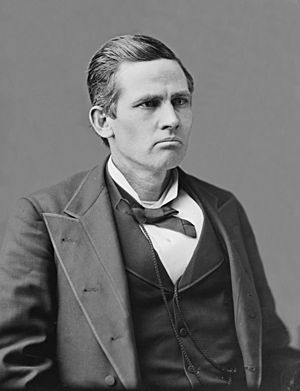James Henderson Blount facts for kids
Quick facts for kids
James Henderson Blount
|
|
|---|---|
 |
|
| Member of the U.S. House of Representatives from Georgia's 6th district |
|
| In office March 4, 1873 – March 3, 1893 |
|
| Preceded by | William P. Price |
| Succeeded by | Thomas B. Cabaniss |
| Personal details | |
| Born | September 12, 1837 Clinton, Jones County, Georgia |
| Died | March 8, 1903 (aged 65) Macon, Bibb County, Georgia |
| Political party | Democratic |
| Alma mater | University of Georgia |
| Occupation | Lawyer |
| Military service | |
| Branch/service | Confederate States Army, United States Army |
| Years of service | 4 years |
James Henderson Blount (born September 12, 1837 – died March 8, 1903) was an important American politician and soldier from Georgia. He is best known for his investigation into the political changes in the Kingdom of Hawai'i in 1893. Blount was against Hawai'i joining the United States, partly because he did not want to add a new non-white group to the American population.
Contents
Early Life and Education
James H. Blount was born near Clinton, in Jones County, Georgia. He went to private schools in Georgia and Tuscaloosa, Alabama. In 1858, he graduated from the University of Georgia in Athens.
After college, he studied law and became a lawyer in Georgia in 1859. During the American Civil War, Blount served as a soldier. He was a private in the Confederate Army for two years. Later, he became a lieutenant colonel for another two years.
Political Career in Congress
Blount served in the United States Congress for 20 years. He represented the sixth district of Georgia. His time in Congress was from 1873 to 1893.
He was a member of the Democratic Party. During his time, he was the Chairman of the House Committee on Foreign Relations. This committee deals with how the U.S. interacts with other countries.
The Hawai'i Investigation
In early 1893, there was a major change in Hawai'i. Queen Lili'uokalani was overthrown from her rule. The new government wanted Hawai'i to become part of the United States.
President Benjamin Harrison supported this idea and sent a treaty to the Senate. However, the next president, Grover Cleveland, was against it. President Cleveland, who was also a Democrat, asked James Blount to investigate the situation. Blount was a private citizen at this time.
The Blount Report
Blount released his findings on July 17, 1893. This report is known as the Blount Report. He suggested that the U.S. should not annex Hawai'i. He believed the native people should be allowed to continue their own way of life.
Blount's report also blamed the U.S. consul for helping with the overthrow. Based on this, President Cleveland wanted to use American military force. His goal was to put Queen Lili'uokalani back in power. However, the Queen refused to promise to forgive the current government leaders. She was also accused of saying she would "behead" them. Because of this, Cleveland sent the matter to Congress.
The Morgan Report and Annexation
The U.S. Senate then created its own report. This report was written by Senator John Tyler Morgan. It was called the Morgan Report. This report disagreed completely with Blount's findings. It stated that the revolution in Hawai'i was an internal matter. This meant it was a problem within Hawai'i itself, not caused by the U.S.
In May 1894, the U.S. passed the Turpie Resolution. This resolution promised that the U.S. would not interfere in Hawai'i's affairs. After this, President Cleveland stopped trying to put the Queen back in power. He officially recognized the new Republic of Hawaii. Other countries had already recognized this new government.
Later, in 1898, the Republic of Hawai'i again asked to join the U.S. This time, with strong support from President McKinley, Congress approved the annexation.
Later Life and Legacy
James Blount passed away on March 8, 1903, at the age of 65. He died in Macon, Bibb County, Georgia. He was buried at the Rose Hill Cemetery in Macon.
The community of Blount, Georgia is named after him.

